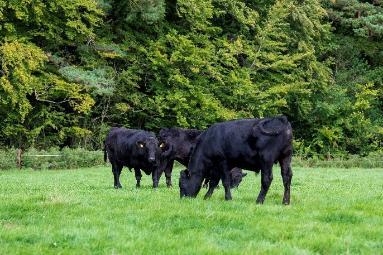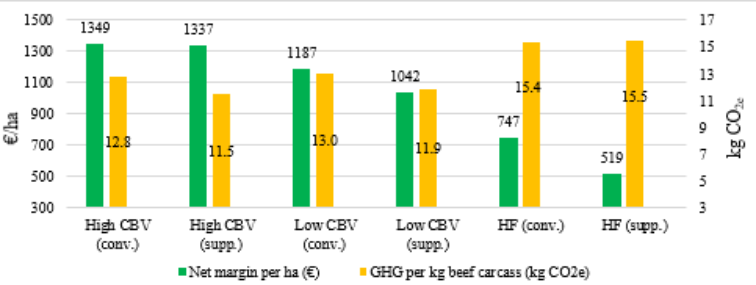Profitable and environmentally sustainable dairy-beef systems
Approximately 60% of Irish beef is product of the dairy herd. Economic and environmental efficiency of dairy-beef production systems is dependent on the application of key technologies in the areas of animal genetics (high beef merit), calf health and rearing and the production of high quality grazed grass and silage. Dairy-beef cattle suit a range of finishing systems from 19 to 28 months of age for heifer and steer systems. The choice of system can be influenced by animal gender and beef genetic potential, farm infrastructure and customer requirements.
Profitable and environmentally sustainable dairy-beef systems (pdf)
Why Dairy-Beef?
- Over 1.1m calves to select from
- An increasing proportion of these are sired by beef bulls, with significant improvements in beef merit possible.
- Can support very high carcass output systems from a predominantly grass-based diet (80-90% forage).
- More structured labour requirement compared to breeding enterprises.
- Profitable options to finish cattle during a second grazing season, second winter or third grazing season.
- Low carbon footprint beef products.
Choosing a Dairy-Beef system for your farm
Choosing a dairy-beef system which suits you and your farm is based on a number of criteria, including land, labour, facilities and work-life balance. The financial return from your most limited resources should be used to evaluate your chosen system. Typically this is land, hence, net margin per hectare (ha) is commonly used. To optimise profit per ha, farmers gene rally have higher stocking rates and target younger finishing ages to support high beef output, through careful animal and grassland management. However, where systems are not restricted by facilities or land resources, and producers are more focused on a work-life balance, lower stocking densities and finishing cattle older, during a ‘third’ grazing season, can provide a good return on labour input.
rally have higher stocking rates and target younger finishing ages to support high beef output, through careful animal and grassland management. However, where systems are not restricted by facilities or land resources, and producers are more focused on a work-life balance, lower stocking densities and finishing cattle older, during a ‘third’ grazing season, can provide a good return on labour input.
-
Labour
How much time can you devote to the farm? Dairy-beef systems have a structured labour requirement in comparison to other livestock enterprises, making them complementary to other on-farm or off-farm enterprises.
-
Facilities
The availability of appropriate housing facilities for calves, weanlings and finishing cattle will determine the most suitable dairy-beef system for your farm. Certain dairy-beef systems require less housing facilities than others. For example, heifers or early-maturing steers, which can be finished during or by the end of the ‘second’ grazing season, offer farmers the opportunity to be well-stocked without further investment in farm buildings.
-
Land/grazing infrastructure
On dairy-beef farms, the ability to support moderate-to-high stocking rates through high levels of grass growth and utilisation is a key driver of profit. The production potential of swards is dependent on land quality, soil fertility, drainage, sward type and level of grazing management/grass budgeting ability. Investment in paddock and roadway infrastructure will improve labour efficiency and facilitate grassland management.
Performance on DairyBeef 500 demonstration farms
- Predominantly Holstein Friesian steer systems
- Average net margin in 2023 was €542/ha (excluding subsidies).
Ranging from €47/ha to €1459/ha. - Key drivers of profitability on farms:
Calf purchase price
Beef price
Grass utilisation
Stocking rate
Animal performance
Analysis of the stocking rate of all DairyBeef 500 demonstration farms in 2023, showed that in order to achieve a margin >€500/ha required a stocking rate of over 170 kg organic N/ha, meaning these farms needed a nitrates derogation. Across the DairyBeef 500 farms a reduction of 10% in stocking rate would result in a reduction in net margin of ~ €267/ha. To improve farm profits farmers are focused on increasing output while maintaining stocking rate by improving animal beef genetic merit. This can be achieved by switching from dairy x dairy steers to high carcass merit beef x dairy steers, that can produce high carcass weights at younger finishing ages. As farmers seek high beef merit calves pricing should be according to Commercial Beef Value (CBV), as excessively high calf purchase prices often exceed their genetic potential and limit farm profit.
Teagasc Grange systems study examining the impact of CBV and feeding strategy on the economic and environmental efficiency of dairy-beef steers
A recent study completed at Teagasc Grange investigated the influence of the Commercial Beef Value (CBV) and concentrate supplementation strategy on profitability/ha and greenhouse gas emissions (GHG) emissions/kg carcass. All calves were born to Holstein-Friesian (HF) dams, and sired by Angus or HF sires. Angus calves were subsequently split into two groups, selected for being either high (4-5 stars) merit (High CBV) or low (1-3 stars) merit (Low CBV), forming three genetic groups including HF. Within each genetic group, half of the animals were assigned to conventional management, receiving a grass-only diet during the second grazing season and being finished indoors from concentrates and grass silage (Conv.), and the other half were supplemented at pasture from the 1st of July in the second grazing season with 4 kg of concentrates until finished at pasture (Supp.). Both High and Low CBV groups that were supplemented with concentrates from the 1st of July were finished without the need of second winter indoors, however HF steers required a housed finishing period, despite being supplemented at pasture.
Figure 1. Profit (€/ha) and carbon efficiency (kg CO2e/kg carcass) of dairy-beef steer systems of contrasting beef merit and feeding strategy.

